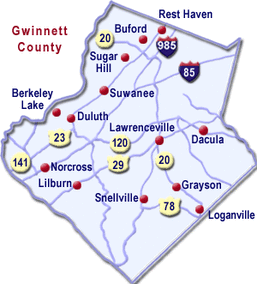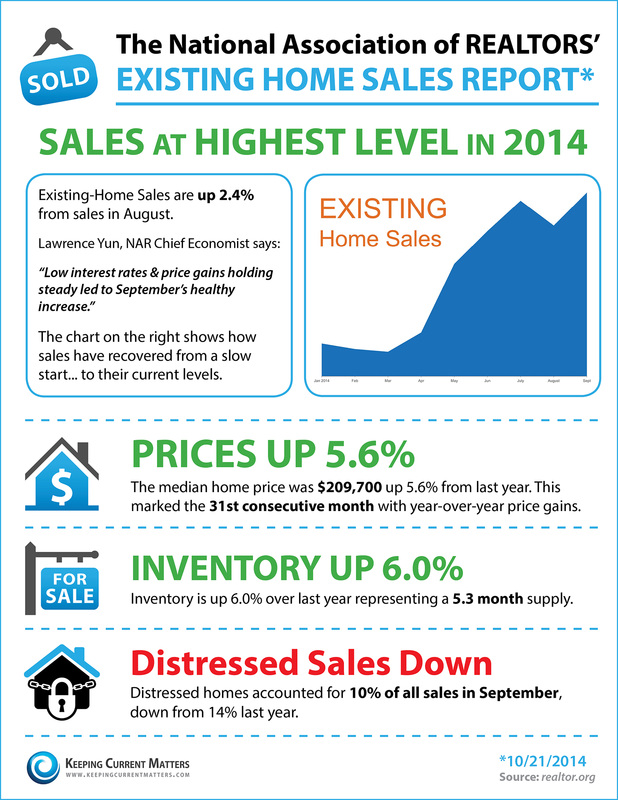 If you've been considering a new home this is the time to call us. We are no longer wondering "if" interest rates will rise, now we are asking "when" and the answer may be sooner than we'd prefer. See the full article from The Washington Post here.  Gwinnett County Market Statistics Summary Total Homes for Sale - 3177 Average List Price - $304,594 Median List Price - $222,900 Typical Gwinnett County Home 4.09 Bedrooms 2.81 Baths Median year Built- 2000 Average Price per Bedroom 3 Bedrooms - $170,938 4 Bedrooms - $250,921 5 Bedrooms - $398,378 There are currently 3177 active homes for sale in Gwinnett County. The average listing price for Homes in Gwinnett County during the month of October is $304,594. The median list price in October for single family residential and condo/town home properties in Gwinnett County is $222,900. The typical home for sale during the month of October in Gwinnett County is a 4.09 bedroom, 2.81 bath home built in 2000. To break down pricing further we can look at price by bedrooms in Gwinnett County. During the month of October a 3 bedroom homes average for sale price is $170,938 while a 4 bedroom homes average for sale price is $250,921. The 5 bedroom homes are listing for an average of $398,378. All market data and statistics are pulled directly from the local MLS data as of October 2014. For more comprehensive Homes data you can go to our website at http://www.homesofgwinnettcounty.com. As reported by the AP, new rules adopted yesterday by six federal agencies include the removal of a big stumbling block for would-be borrowers: the 20 percent down payment if a lender didn’t hold at least 5 percent of the mortgage securities tied to those loans on its books.
According to the AP article, which appeared on abcnews.com, the final rules released Tuesday will include the more relaxed requirement that borrowers not carry excessive debt relative to their income. The board of the Federal Deposit Insurance Corp. voted 4-1 Tuesday to adopt the rules, and the Federal Reserve is scheduled to vote today, along with four other agencies. According to Mel Watt, director of the Federal Housing Finance Agency, “Finalizing this rule represents a major step forward to providing greater certainty to the housing finance market and paves the way for increased participation by the private sector. Aligning the Qualified Residential Mortgage standard with the existing Qualified Mortgage definition also means more clarity for lenders and encourages safe and sound lending to creditworthy borrowers. Lenders have wanted and needed to know what the new rules of the road are and this rule defines them.” Proposed in the wake of the 2008 financial meltdown, the Qualified Mortgage (QM) rule put forth by the Consumer Financial Protection Bureau (CFPB) was designed to restrict the unsafe lending practices that led to the downturn. According to the AP article, “CFPB Director Richard Cordray, a member of the FDIC board, noted at Tuesday's meeting that conditions in the mortgage market have changed since the financial crisis and the time of the enactment of the 2010 overhaul law, when anxiety over reckless lending gripped lawmakers.” The real estate industry and mortgage bankers have been fiercely lobbying against the 20-percent down payment requirement, emphasizing that it could limit access to mortgage financing for low- and moderate-income borrowers and thereby, severely hamper the housing recovery. “NAR applauds the Federal Deposit Insurance Corporation for finalizing the Qualified Residential Mortgage rule today, which includes a broad definition of QRM and aligns with the Qualified Mortgage standard implemented earlier this year," said NAR President Steve Brown, co-owner of Irongate Inc. REALTORS® in Dayton, Ohio, in a statement released Tuesday. "REALTORS® are confident that the new QRM rule will encourage sound and financially prudent mortgage financing by lenders while also ensuring responsible homebuyers have access to safe and affordable credit. The synchronization with the QM rule will provide lenders with much needed clarity and consistency as they apply the new standards to loan applications while also providing a framework to bring more competition to the secondary mortgage market." According to Don Frommeyer, CEO of NAMB – The Association of Mortgage Professionals, this move is long overdue and will have a notable impact on the housing market and the economy as a whole. “Perhaps Ben Bernanke’s admission that he couldn’t refinance his home loan got some people talking,” said Frommeyer in a statement released Tuesday. “The reality is, if Main Street homebuyers can’t finance a mortgage, it doesn’t matter how good rates are. It doesn’t matter how low unemployment is. The economy will not fully recover. This is exactly what we need.” According to NAMB, under the new proposal, banks would be able to offer financing options to people with less-than-perfect credit, and be protected from accusations of making bad loans. Down payments could go as low as three percent. Some argue this will lead to another housing bust, but Frommeyer argues that with consumer confidence and home prices on the rise, it’s the right move at the right time. “So many people have poor credit because they were forced to foreclose on their home,” said Frommeyer. “If we don’t figure out a way to get them back into a home, the housing market doesn’t stand a chance.” “We are largely pleased with the Qualified Residential Mortgage final rule released today, which will help ensure the largest number of creditworthy borrowers are able to access safe, quality loan products at competitive prices,” said Frank Keating, president and CEO of the American Bankers Association (ABA) in a statement released on Tuesday.” By law, the QRM definition cannot cover more loans than the existing Qualified Mortgage rule, but it might have been more restrictive. Gratefully, the QRM definition aligns with QM, an approach ABA has strongly advocated. This will encourage lenders to continue offering carefully underwritten QM loans, and avoid placing further hurdles before qualified borrowers, allowing them to achieve the American dream of homeownership. ABA and its member banks look forward to working with regulators to ensure we’re able to continue to make the home loans that help drive the economy forward.” The rules for mortgage securities will take effect in a year, according to the AP. For other kinds of securities, which don't allow banks an exemption from the 5-percent rule, the effective date is in two years. Reprinted with permission from RISMedia. ©2014. All rights reserved.  Later this week, after several years of back-and-forth debate, U.S. regulators are finally set to finalize a more relaxed set of mortgage standards. This new set of rules will be a win for the real estate industry, with the projected agreement much more moderate than the mortgage security standards proposed back in 2011. The federal reserve is scheduled to hold an open meeting on Wednesday, October 22, with five other regulators signing off before the end of the month. “NAR has strongly advocated for a Qualified Residential Mortgage rule that encourages sound and financially prudent mortgage financing by lenders while also ensuring responsible homebuyers have access to safe and affordable credit,” said NAR President Steve Brown, co-owner of Irongate Inc. REALTORS® in Dayton, Ohio. “We hope that the final rule will align with the broadly defined Qualified Mortgage / Ability-to-Repay rules that were implemented in January. Synchronization will provide lenders with much needed clarity and consistency as they apply the new standards to loan applications.” These new set of rules will hopefully avoid a repeat of the real estate melt-down in 2008 by slashing the pre-existing requirement—extending from the 2010 Dodd-Frank law—that borrowers make a 20 percent down payment to get a qualified residential mortgage. New, lighter rules will instead require that loans comply with a separate set of mortgage standards written by the U.S. Consumer Financial Protection Bureau. These standards will evaluate allowed debt a borrower can take on in relation to their monthly income. For more information, visit last week's article appearing in the Wall Street Journal. Reprinted with permission from RISMedia. ©2014. All rights reserved.
 We value the safety of our friends and their families! Please take a few moments to review the following tips from the CDC to help ensure safe and happy Halloweens for years to come. Halloween Health and Safety Tips Autumn holidays like Halloween and Harvest Day are fun times for children of all ages, who can dress up in costumes, enjoy parties, enjoy fall fruits and vegetables, and eat yummy treats. These celebrations also provide a chance to give out healthy snacks, get physical activity, and focus on safety. Check out these tips to help make the festivities fun and safe for trick-or-treaters and party guests. Going trick-or-treating?
Expecting trick-or-treaters or party guests? Follow these tips to help make the festivities fun and safe for everyone:
Source: http://www.cdc.gov/family/halloween/ For more information on Halloween safety:
|
David and Amanda BlantonMake the Wise Move! Categories
All
Testimonials 557886  David is awesome to work with. He knows the area very well. He is extremely responsive, always took my calls and answered my emails and txts. He truly ... more David is awesome to work with. He knows the area very well. He is extremely responsive, always took my calls and answered my emails and txts. He truly ... more   5.0/5.0 5.0/5.0 by philipkupersavage 557657  David was extremely helpful.....We were very picky buyers & he never pressured us to look at a house outside of our parameters or place an offer... he ... more David was extremely helpful.....We were very picky buyers & he never pressured us to look at a house outside of our parameters or place an offer... he ... more   5.0/5.0 5.0/5.0 by dwcourter 309784  Mr. Blanton helped us find the home of our dreams and he did by listening to what we wanted. He taught us about the housing market, guided us in the ... more Mr. Blanton helped us find the home of our dreams and he did by listening to what we wanted. He taught us about the housing market, guided us in the ... more   5.0/5.0 5.0/5.0 by user30821228 Archives
May 2016
Categories
All
|



 RSS Feed
RSS Feed
